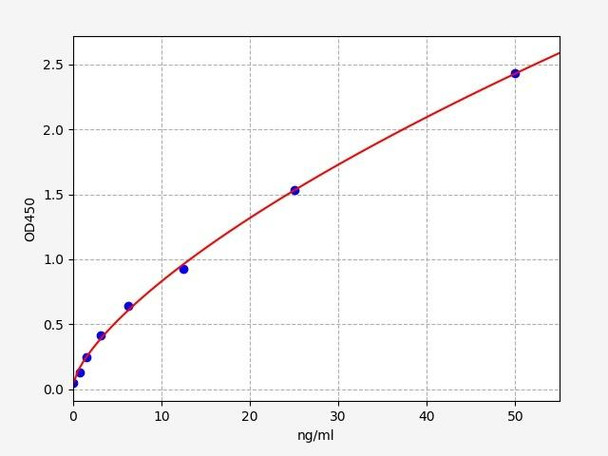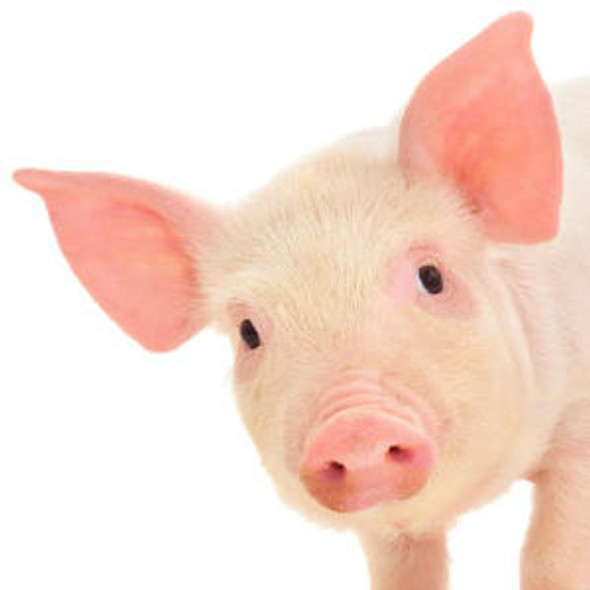Description
Human RAB11A ELISA Kit
RAB11A belongs to the Rab family of the small GTPase superfamily, which is associated with both constitutive and regulated secretory pathways. RAB11A may be involved in regulation of PLK1 activity during the cell cycle and translocation of GLUT4 to the plasma membrane. Diseases associated with RAB11A include Autosomal Dominant Non-Syndromic Intellectual Disability and Charcot-Marie-Tooth Disease. The Assay Genie Human RAB11A ELISA Kit is a highly sensitive assay for the quantitative measurement of RAB11A in serum, blood, plasma, cell culture supernatant and tissue samples.
| Product Name: | Human RAB11A ELISA Kit |
| Product Code: | HUFI01587 |
| Size: | 96 Assays |
| Alias: | RAB11A, Ras-related protein Rab-11A, Rab-11, YL8, RAB11 |
| Detection method: | Sandwich ELISA, Double Antibody |
| Application: | This immunoassay kit allows for the in vitro quantitative determination of Human RAB11A concentrations in serum plasma and other biological fluids. |
| Sensitivity: | 0.469ng/ml |
| Range: | 0.781-50ng/ml |
| Storage: | 4°C for 6 months |
| Note: | For Research Use Only |
| Recovery: | Matrices listed below were spiked with certain level of Human RAB11A and the recovery rates were calculated by comparing the measured value to the expected amount of Human RAB11A in samples. | ||||||||||||||||
| |||||||||||||||||
| Linearity: | The linearity of the kit was assayed by testing samples spiked with appropriate concentration of Human RAB11A and their serial dilutions. The results were demonstrated by the percentage of calculated concentration to the expected. | ||||||||||||||||
| |||||||||||||||||
| CV(%): | Intra-Assay: CV<8% Inter-Assay: CV<10% |
| Component | Quantity | Storage |
| ELISA Microplate (Dismountable) | 8×12 strips | 4°C for 6 months |
| Lyophilized Standard | 2 | 4°C/-20°C |
| Sample/Standard Dilution Buffer | 20ml | 4°C |
| Biotin-labeled Antibody(Concentrated) | 120ul | 4°C (Protect from light) |
| Antibody Dilution Buffer | 10ml | 4°C |
| HRP-Streptavidin Conjugate(SABC) | 120ul | 4°C (Protect from light) |
| SABC Dilution Buffer | 10ml | 4°C |
| TMB Substrate | 10ml | 4°C (Protect from light) |
| Stop Solution | 10ml | 4°C |
| Wash Buffer(25X) | 30ml | 4°C |
| Plate Sealer | 5 | - |
Other materials and equipment required:
- Microplate reader with 450 nm wavelength filter
- Multichannel Pipette, Pipette, microcentrifuge tubes and disposable pipette tips
- Incubator
- Deionized or distilled water
- Absorbent paper
- Buffer resevoir
| Uniprot | P62491 |
| UniProt Protein Function: | RAB11A: Regulates endocytic recycling. May exert its functions by interacting with multiple effector proteins in different complexes. Acts as a major regulator of membrane delivery during cytokinesis. Together with MYO5B and RAB8A participates in epithelial cell polarization. Together with RAB3IP, RAB8A, the exocyst complex, PARD3, PRKCI, ANXA2, CDC42 and DNMBP promotes transcytosis of PODXL to the apical membrane initiation sites (AMIS), apical surface formation and lumenogenesis. Together with MYO5B participates in CFTR trafficking to the plasma membrane and TF (Transferrin) recycling in nonpolarized cells. Required in a complex with MYO5B and RAB11FIP2 for the transport of NPC1L1 to the plasma membrane. Participates in the sorting and basolateral transport of CDH1 from the Golgi apparatus to the plasma membrane. Regulates the recycling of FCGRT (receptor of Fc region of monomeric Ig G) to basolateral membranes. Interacts with RIP11 and STXBP6. Interacts with SGSM1, SGSM2 and SGSM3. Interacts with EXOC6 in a GTP- dependent manner. Interacts with RAB11FIP1, RAB11FIP2, RAB11FIP3 (via its C-terminus) and RAB11FIP4. Interacts with EVI5; EVI5 and RAB11FIP3 may be mutually exclusive and compete for binding RAB11A. Interacts with SPE39//C14orf133. Interacts with MYO5B. Found in a complex with MYO5B and CFTR. Interacts with NPC1L1. Interacts (GDP-bound form) with ZFYVE27. Interacts with BIRC6/bruce. Belongs to the small GTPase superfamily. Rab family. |
| UniProt Protein Details: | Protein type:G protein, monomeric; G protein; G protein, monomeric, Rab; Motility/polarity/chemotaxis Chromosomal Location of Human Ortholog: 15q22.31 Cellular Component: Golgi apparatus; spindle pole; protein complex; cytoplasmic vesicle membrane; mitochondrion; recycling endosome membrane; phagocytic vesicle; trans-Golgi network; cytosol; kinetochore microtubule; multivesicular body; recycling endosome; phagocytic vesicle membrane; transport vesicle; perinuclear region of cytoplasm; axon; plasma membrane; cytoplasmic vesicle; vesicle; cleavage furrow Molecular Function:GTPase activity; protein binding; GDP binding; syntaxin binding; GTP binding; microtubule binding; myosin V binding Biological Process: regulation of long-term neuronal synaptic plasticity; establishment of vesicle localization; exocytosis; metabolic process; organelle organization and biogenesis; positive regulation of axon extension; water transport; cytokinesis; melanosome transport; mitotic metaphase plate congression; vesicle-mediated transport; regulation of protein transport; intracellular protein transport; astral microtubule organization and biogenesis; renal water homeostasis; plasma membrane to endosome transport; Rab protein signal transduction; transmembrane transport; neurite development |
| NCBI Summary: | The protein encoded by this gene belongs to the Rab family of the small GTPase superfamily. It is associated with both constitutive and regulated secretory pathways, and may be involved in protein transport. Two transcript variants encoding different isoforms have been found for this gene. [provided by RefSeq, May 2011] |
| UniProt Code: | P62491 |
| NCBI GenInfo Identifier: | 50402542 |
| NCBI Gene ID: | 8766 |
| NCBI Accession: | P62491.3 |
| UniProt Secondary Accession: | P62491,P24410, Q5TZN9, Q9JLX1, B2R4B6, B4DT13, |
| UniProt Related Accession: | P62491 |
| Molecular Weight: | 17,659 Da |
| NCBI Full Name: | Ras-related protein Rab-11A |
| NCBI Synonym Full Names: | RAB11A, member RAS oncogene family |
| NCBI Official Symbol: | RAB11A |
| NCBI Official Synonym Symbols: | YL8 |
| NCBI Protein Information: | ras-related protein Rab-11A; rab-11; RAB 11A, member oncogene family |
| UniProt Protein Name: | Ras-related protein Rab-11A |
| UniProt Synonym Protein Names: | YL8 |
| Protein Family: | Ras-related protein |
| UniProt Gene Name: | RAB11A |
| UniProt Entry Name: | RB11A_HUMAN |
*Note: Protocols are specific to each batch/lot. For the correct instructions please follow the protocol included in your kit.
Before adding to wells, equilibrate the SABC working solution and TMB substrate for at least 30 min at 37°C. When diluting samples and reagents, they must be mixed completely and evenly. It is recommended to plot a standard curve for each test.
| Step | Protocol |
| 1. | Set standard, test sample and control (zero) wells on the pre-coated plate respectively, and then, record their positions. It is recommended to measure each standard and sample in duplicate. Wash plate 2 times before adding standard, sample and control (zero) wells! |
| 2. | Aliquot 0.1ml standard solutions into the standard wells. |
| 3. | Add 0.1 ml of Sample / Standard dilution buffer into the control (zero) well. |
| 4. | Add 0.1 ml of properly diluted sample ( Human serum, plasma, tissue homogenates and other biological fluids.) into test sample wells. |
| 5. | Seal the plate with a cover and incubate at 37 °C for 90 min. |
| 6. | Remove the cover and discard the plate content, clap the plate on the absorbent filter papers or other absorbent material. Do NOT let the wells completely dry at any time. Wash plate X2. |
| 7. | Add 0.1 ml of Biotin- detection antibody working solution into the above wells (standard, test sample & zero wells). Add the solution at the bottom of each well without touching the side wall. |
| 8. | Seal the plate with a cover and incubate at 37°C for 60 min. |
| 9. | Remove the cover, and wash plate 3 times with Wash buffer. Let wash buffer rest in wells for 1 min between each wash. |
| 10. | Add 0.1 ml of SABC working solution into each well, cover the plate and incubate at 37°C for 30 min. |
| 11. | Remove the cover and wash plate 5 times with Wash buffer, and each time let the wash buffer stay in the wells for 1-2 min. |
| 12. | Add 90 µl of TMB substrate into each well, cover the plate and incubate at 37°C in dark within 10-20 min. (Note: This incubation time is for reference use only, the optimal time should be determined by end user.) And the shades of blue can be seen in the first 3-4 wells (with most concentrated standard solutions), the other wells show no obvious color. |
| 13. | Add 50 µl of Stop solution into each well and mix thoroughly. The color changes into yellow immediately. |
| 14. | Read the O.D. absorbance at 450 nm in a microplate reader immediately after adding the stop solution. |
When carrying out an ELISA assay it is important to prepare your samples in order to achieve the best possible results. Below we have a list of procedures for the preparation of samples for different sample types.
| Sample Type | Protocol |
| Serum | If using serum separator tubes, allow samples to clot for 30 minutes at room temperature. Centrifuge for 10 minutes at 1,000x g. Collect the serum fraction and assay promptly or aliquot and store the samples at -80°C. Avoid multiple freeze-thaw cycles. If serum separator tubes are not being used, allow samples to clot overnight at 2-8°C. Centrifuge for 10 minutes at 1,000x g. Remove serum and assay promptly or aliquot and store the samples at -80°C. Avoid multiple freeze-thaw cycles. |
| Plasma | Collect plasma using EDTA or heparin as an anticoagulant. Centrifuge samples at 4°C for 15 mins at 1000 × g within 30 mins of collection. Collect the plasma fraction and assay promptly or aliquot and store the samples at -80°C. Avoid multiple freeze-thaw cycles. Note: Over haemolysed samples are not suitable for use with this kit. |
| Urine & Cerebrospinal Fluid | Collect the urine (mid-stream) in a sterile container, centrifuge for 20 mins at 2000-3000 rpm. Remove supernatant and assay immediately. If any precipitation is detected, repeat the centrifugation step. A similar protocol can be used for cerebrospinal fluid. |
| Cell culture supernatant | Collect the cell culture media by pipette, followed by centrifugation at 4°C for 20 mins at 1500 rpm. Collect the clear supernatant and assay immediately. |
| Cell lysates | Solubilize cells in lysis buffer and allow to sit on ice for 30 minutes. Centrifuge tubes at 14,000 x g for 5 minutes to remove insoluble material. Aliquot the supernatant into a new tube and discard the remaining whole cell extract. Quantify total protein concentration using a total protein assay. Assay immediately or aliquot and store at ≤ -20 °C. |
| Tissue homogenates | The preparation of tissue homogenates will vary depending upon tissue type. Rinse tissue with 1X PBS to remove excess blood & homogenize in 20ml of 1X PBS (including protease inhibitors) and store overnight at ≤ -20°C. Two freeze-thaw cycles are required to break the cell membranes. To further disrupt the cell membranes you can sonicate the samples. Centrifuge homogenates for 5 mins at 5000xg. Remove the supernatant and assay immediately or aliquot and store at -20°C or -80°C. |
| Tissue lysates | Rinse tissue with PBS, cut into 1-2 mm pieces, and homogenize with a tissue homogenizer in PBS. Add an equal volume of RIPA buffer containing protease inhibitors and lyse tissues at room temperature for 30 minutes with gentle agitation. Centrifuge to remove debris. Quantify total protein concentration using a total protein assay. Assay immediately or aliquot and store at ≤ -20 °C. |
| Breast Milk | Collect milk samples and centrifuge at 10,000 x g for 60 min at 4°C. Aliquot the supernatant and assay. For long term use, store samples at -80°C. Minimize freeze/thaw cycles. |
Fill out our quote form below and a dedicated member of staff will get back to you within one working day!






